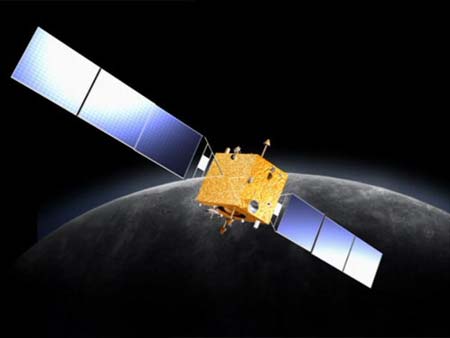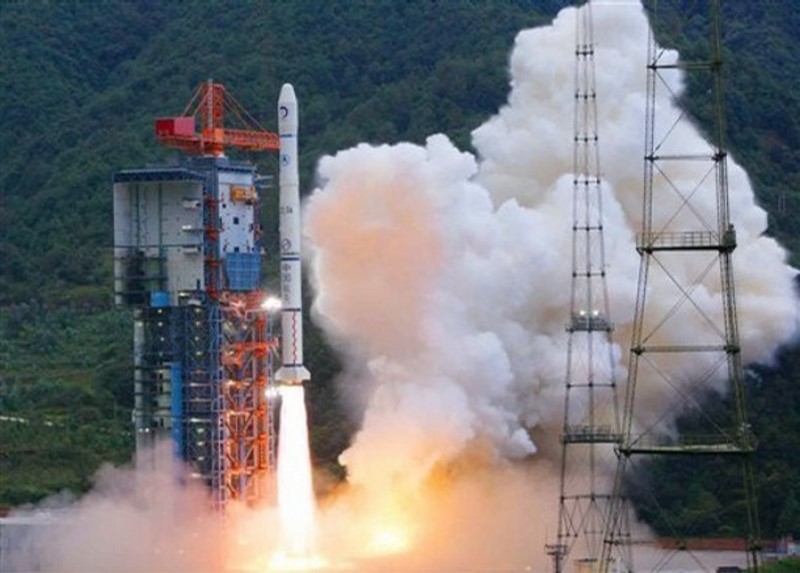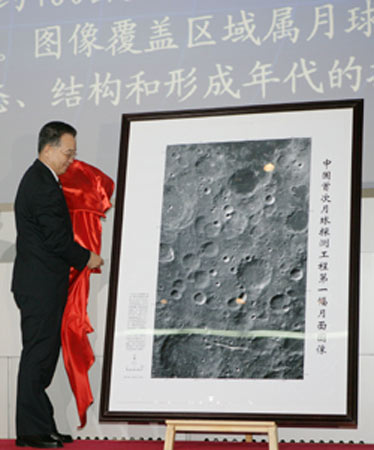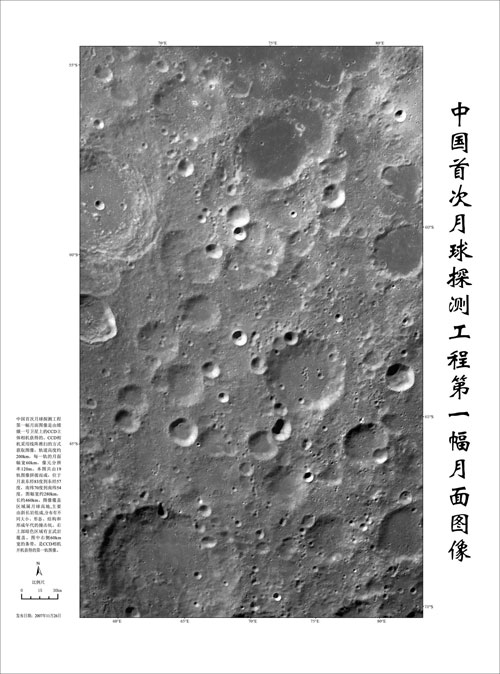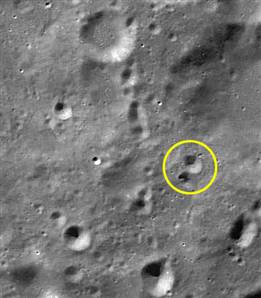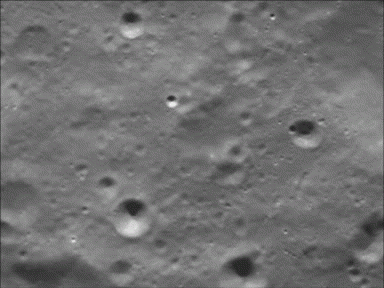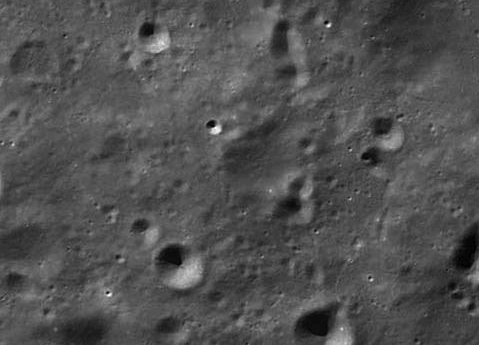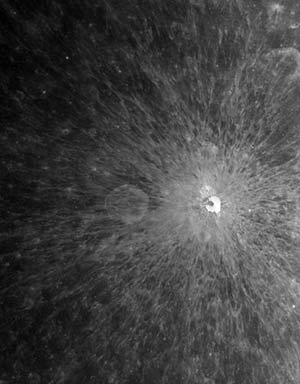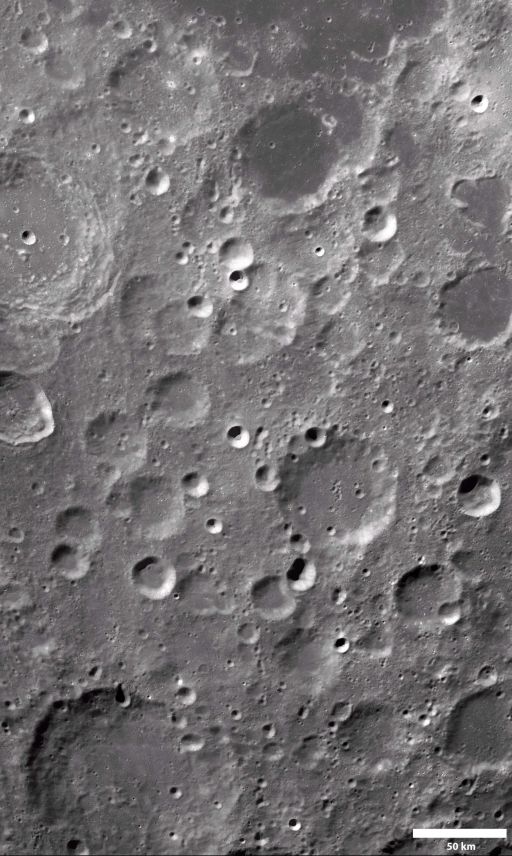|
China National Space Administration Chang'e-1 |
|||
|
..
Kunming, China (XNA) Apr 24,
2006
Chinese scientists in early April completed the main part of a high-tech radio telescope which will serve China's ambitious moon-probe project scheduled for launch in 2007. The 45-meter tall telescope weighs 400 tons and measures 40 meters in diameter of the antenna. It's located in southwest China's Yunnan Province and is the country's second largest radio telescope. The largest is being built in Beijing. According to Li Yan, director of Yunnan Observatory of Chinese Academy of Sciences, together with two radio telescopes already set up in Shanghai and northwest China's Xinjiang Uygur Autonomous Region, China now has four large radio telescopes which are 2,000 to 3,000 kilometers apart from each other. The telescopes will form a comprehensive earth-based research and survey network that will be able to detect, track and retrieve data sent back from China's first moon-orbiting satellite, Li said. Located on top of the 2000-meter-tall Mountain Phoenix in an eastern suburb of Kunming, capital city of Yunnan Province, the newest radio telescope is "superbly well positioned", the scientist said. The construction of the telescope started in August last year and will be completely installed and tested by June. Source: Moon
Daily
|
|||
|
Chang'e 1 Launch ..
And there goes Chang'e 1 towards the Moon! Congratulations to the People's Republic of China for this extraordinary achievement that marks a whole new ground... From here nothing will be the same in space exploration... China performed a successful launch of the spacecraft on the first step of its ambitious three-stage moon mission. Chang'e-1 was launched on a Long March3A carrier rocket at 6:05 p.m. from the No. 3 launching tower in the Xichang Satellite Launch Center on southwest Sichuan Province. Chang'e-1, named after a legendary Chinese goddess who is said to have flied to the moon, is expected to enter earth-moon transfer orbit on October 31 and arrive in the moon's orbit on November 5. Times are changing fast... |
|||
|
China Shows First Image from Lunar Probe ..
China hopes satellite will surveyed entire moon surface by early next year Mon., Nov. 26, 2007 BEIJING - China displayed the first image of the moon captured by its Chang-e 1 lunar probe at a gala ceremony Monday, marking the formal start of the satellite's mission to document the lunar landscape. Unveiling the image at the Beijing Aerospace Control Center, Premier Wen Jiabao hailed it as a major step in "the Chinese race's 1,000-year-old dream" of exploring the moon. China hopes the probe, launched late last month, will have surveyed the entire surface of the moon at least once by early next year. The probe's launch closely followed the start of a similar mission by Japan, prompting speculation over a new space race in Asia. India plans to launch a lunar probe in April. Chinese officials have however played down talk of such competition, saying Beijing wanted to use its program to work with other countries and hoped to join in building the international space station. In 2003, China became only the third country in the world after the United States and Russia to send a human into orbit, following that up with a two-man mission in 2005. SOURCE: MSNBC News © 2008 The Associated Press |
|||
|
China Publishes First Moon Picture 2007-11-26 ..
.. Chinese Moon Photo Issued Nov. 26, 2007 ...
SOURCE: CNSA |
|||
|
Data from Chinese Lunar Orbiter Available to All ..
SHANGHAI, Dec. 2, 2007 (Xinhua) Scientists and astronomy enthusiasts all over the country all have access to data sent back from China's first lunar orbiter Chang'e-I, a leading scientist in the program said here Sunday. Ouyang Ziyuan, academician of the Chinese Academy of Sciences (CAS) and chief scientist of the lunar exploration program, said at present the scientific instruments on board Chang'e-1 have all gone into operation and the satellite is sending back 3 trillion of data per second. The total data volume will reach 28 T (1 T is equivalent to 1,000 G) next year. "The money used for the Chang'e project comes from the taxpayers and, therefore, the data should also be made public. Any scientist or astronomy lover can apply to the state in accordance with certain procedures to obtain data he needs," Ouyang said. He also refuted rumors spread by some Chinese netizens that the first image sent back by Chang'e-I "copied the picture from the United States". "Because China and the United States took the images in the same region, it's natural the two pictures look alike. But through careful observation you will see there are some nuances," he said. He further explained that scientist have already learned a lot of information from the first image. "We can see many craters on the lunar surface, some are of bowl's shape, some are center conical pits, and most of all, there are multi-loop pits. These craters show that the moon has experienced different disasters." China published the first picture of the moon captured by Chang'e-1 last Monday, marking the success of the country's first lunar probe project. The image showed a rough moon surface with scattered round craters both big and small. SOURCE: China View |
|||
|
China Says Moon Pictures Not Faked From NASA December 2, 2007 Reuters Posted on Monday, December 03, 2007 2:49:51 AM by JACKRUSSELL (BEIJING) - China has dismissed Internet gossip that its first photo of the moon taken from a lunar orbiter might have been plagiarised from NASA, local media said on Monday. The country launched its first lunar probe, the Chang'e 1, in October and released a photo featuring a patch of grey moon surface splotched with craters last week, hailing the mission as a "complete success". But some Chinese Internet users have questioned its originality after comparing it with an almost identical lunar image from the U.S. National Aeronautics and Space Administration in 2005. "There is absolutely no forgery," Ouyang Ziyuan, chief scientist for the lunar probe, told the Beijing News. The Chinese and U.S. lunar images looked similar only because they had aimed at the same area of the moon's southern hemisphere, Ouyang was quoted as saying. "But a careful examination will tell some small differences," Ouyang said. There were two craters on a certain spot of the Chinese photo, but there was only one on that same spot of the American picture, the Beijing News quoted him as saying. "Maybe it's because the resolution of the American photo was not high enough, or a new pit might have been generated by an asteroid hitting the moon between 2005 and 2007," Ouyang said. "I understand the doubts of the Internet surfers. They hope the Chinese lunar probe can do well so they don't want the photo to turn out to be fake," he said. A three-dimensional image of the moon surface taken by the Chang'e 1 was released on Sunday and some data collected by the satellite would be shared with the public, the Beijing News said. China has an ambitious space programme, eyeing its scientific and military benefits as well as domestic political gains from its boost to patriotism. In 2003, China became only the third country to put a man into space using its own rocket after the former Soviet Union and the United States. It then sent two astronauts on a five-day flight on its Shenzhou VI mission in October 2005. It plans to launch a third manned mission, Shenzhou VII, into space next year which would involve a space walk. Other Asian powers have also announced lunar plans. Japan launched its first lunar satellite in September and India plans one in 2008. |
|||
|
Moon Photo Mystery Solved ..
Posted: Tuesday, December 04, 2007 5:30 PM by Alan Boyle Cosmic Log MSNBC Some dogged sleuthing by a fellow space blogger has tracked down the truth behind the controversial first photo from China's moon orbiter. In the week since the picture was released amid much fanfare in Beijing, there have been widespread rumors that the photo was a fake, copied from an old picture collected by a U.S. space probe. The good news for the Chinese is that Planetary Society blogger Emily Lakdawalla's clears them of outright fakery. The bad news is, she found evidence that the photo was badly retouched for public release. Lakdawalla's explanation would be embarrassing for Beijing, but it makes the most sense as the solution to this week's moon photo mystery. Lakdawalla began her investigation by plowing through databases of lunar imagery and dredging up a U.S.-produced picture for comparison. It's not a NASA picture, as reported by the rumor mill. Instead, it's one of the tens of thousands of pictures taken by the Pentagon's Clementine lunar mapping orbiter back in 1994. The photo from China's Chang'e 1 orbiter is clearly a higher-resolution view, with sunlight streaming from the northwest rather than the north. "So the notion that China faked their lunar photo can be put to rest. (What is it about the moon and conspiracy theories, anyway?)," Lakdawalla wrote. "At least it certainly isn't a copy of the Clementine image; and it's certainly not a Lunar Orbiter image, either." Case closed? Not quite. Lakdawalla found that a mistake was apparently made in stitching together the 19 strips of imagery to produce the finished picture - and that Chinese officials unknowingly pointed out that mistake as they defended the photo's veracity. 
NASA / DOD / CAST The mission's chief scientist, Ouyang Ziyuan, told the Beijing News that a new crater had been spotted on the Chang'e imagery - a crater that didn't appear on the U.S. imagery. Lakdawalla determined that crater in question it wasn't exactly new - instead, it appeared to be a crater that had been moved from one spot on the picture to another spot slightly south. Lakdawalla, who knows her way around spacecraft photo databases as well as photo-retouching tools, hit upon the likeliest explanation for the gaffe. Often, surface features that show up on two strips of data have to be manually corrected to produce the finished image, due to subtle changes in perspective. "You know that there should have been seams in that image, and I just did not look for them carefully at the time," Lakdawalla told me today. She said the Chinese must have blended together the seams between the strips - misplacing the crater. The picture may be pretty, but it's pretty much useless as a scientific product, Lakdawalla said. The detective work came in for kudos from other space mythbusters. "Go check out her really amazing sleuthing," said Bad Astronomy blogger Phil Plait. "This is how it's done, folks. Case closed!" NBC News space analyst James Oberg, who has had his own experience with moon-hoax controversies, also saluted Lakdawalla's efforts. Even though the Chinese insist that the first picture from Chang'e is scientifically accurate, Oberg said he expected the Chinese to "be forced to backtrack a bit" once they see the full evidence. "This isn't the first time that photo problems have created illusory 'moon features,'" Oberg wrote in an e-mail. "The very first Soviet moon photo probe, Luna 3 in 1959, sent back images of the back side that included a view of what Moscow grandiosely called 'the Soviet Mountains,' stretching for hundreds of miles. It turned out to be an emulsion smear on the negative." "For a 'dead world,' the moon sure continues to offer surprises to explorers," Oberg said, "even if many of the 'surprises' are self-induced flaws in the exploration process!" SOURCE: Cosmic Log MSNBC
"So, in a way, the story has come full circle. The Chang'e image isn't a fake as far as I can tell; my personal opinion, based upon the evidence I was able to dig up, is that the Chinese do have an orbiter at the Moon, and that it is producing really beautiful images that are a great improvement over Clementine. But the one released image is a processed product, and was altered slightly (the seams were blended away) to make it pretty. This alteration made it difficult for a scientist to realize that what appeared to be a new feature was in fact an artifact." - Emily Lakdawalla Planetary Society Related Links:
|
|||
| Chang’e-1 journey “successful”
Nov 08, 2007
BEIJING: China’s first lunar probe, Chang’e-1, completed its around two-million-km journey to the moon successfully on Wednesday and entered its working orbit. The probe started its third braking at 8:24 a.m. and entered a 127-minute round polar circular orbit at around 8:35 a.m. after completing the braking. “It puts a successful end to the probe’s long flight to the moon,” said Luan Enjie, chief commander. “The satellite entered the designed working orbit just in time and very accurately today,” said Mr. Sun Jiadong, chief designer of the project, who has joined hands with Mr. Luan for more than a decade to develop, test and carry out the country’s ambitious lunar probe project. “The probe will travel along the orbit at a stable altitude of 200 km above the moon’s surface. In each circle, it will always pass the two poles,” said Wang Yejun, chief engineer of the Beijing Aerospace Control Center (BACC). The round orbit is also the final destination of the probe, where it is supposed to start carrying out all the planned scientific exploration tasks. “The probe’s precise entry into the orbit has laid a solid foundation for its future work, and we are confident that Chang’e-1 will continue to fulfil the aims step by step,” said an official. — Xinhua © Copyright 2000 - 2008 The Hindu SOURCE: The Hindu |
|||
|
November 27, 2007 China's space experts have predicted that the country will publish the whole lunar 3D image in January next year. On Monday, China published its first moon image sent back by its lunar probe Chang'e-1, named after a mythical Chinese goddess who flew to the moon. The picture was pieced together from 19 images, each covering a width of 60 kilometers of the moon's surface. The area covered by the picture, about 460 kilometers in length and 280 kilometers in width, is located within a 54 to 70 degrees south latitude and 57 to 83 degrees east longitude on the moon, according to sources with Beijing Aerospace Control Center (BACC). Wu Ji, director of the Center of Space Science and Applied Research under CAS, the China Academy of Sciences, explained that the released image is a 2D picture, and researchers are working on the data sent back to formulate a 3D image, hoping to publish the picture as soon as possible. The camera aboard China's lunar probe Chang'e-1 is a high performance CCD (Charge Coupled Device) stereo camera, which has three lenses to take photos of the lunar surface from three different angles to build up a 3D image. Hao Xifan, deputy director of the Lunar Exploration Center of China's Commission of Science Technology and Industry for National Defense, said that the 3D image will possibly be published in January next year. Chang'e-1 is expected to photograph the whole lunar surface in a month, as the moon's rotation period is one month. After Chang'e-1 sends back the data, researchers have to spend months piecing together the data and complete the entire lunar surface image. Jiang Jingshan, designer with the Chinese Lunar Orbiting Exploration program, said he was nervous when the camera first sent back a black image. But after a few seconds, clear images of the moon craters appeared, bringing much excitement to the space center. Beijing Times reported that the Chief scientist Ouyang Ziyuan appraised the first image as very good. He said the image was only the start of Chang'e-1's exploration of the moon, and other pieces of equipment aboard the probe were still under testing. (CRI November 27, 2007) SOURCE: China.org.cn |
|||
|
Chinese Moon Photo Issued Dec. 11, 2007 ..
|
|||
|
Chinese Moon Photo Issued Nov. 26, 2007 ..
Click on the image above for the full resolution 120 meters per pixel, 2278 by 3810 pixels in size |
|||
| FAIR USE NOTICE: This page contains copyrighted material the use of which has not been specifically authorized by the copyright owner. Pegasus Research Consortium distributes this material without profit to those who have expressed a prior interest in receiving the included information for research and educational purposes. We believe this constitutes a fair use of any such copyrighted material as provided for in 17 U.S.C § 107. If you wish to use copyrighted material from this site for purposes of your own that go beyond fair use, you must obtain permission from the copyright owner. | |||
|
|
